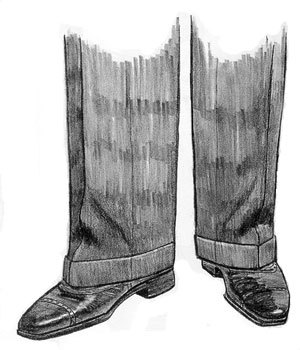
Darren writes: When you write about pants slacking due to excess fabric, how should they be tailored? I have some shoes that fall lower on the ankle than do others, so I am wondering if there is a certain point on my leg where my pant leg should rest or should it be based on a standard type of dress shoe?
It’s exceedingly important to wear the type of shoes you’ll be wearing with your pants when your tailor is fitting you. If you don’t, and if you don’t wear your pantwaist where you intend to do so in real life, everything your tailor does will be guesswork.
Now, how should your pants be finished? That’s a matter of personal taste. Here, however, are a few guidelines.
Cuffs or no cuffs?
Casual pants, like chinos, should be finished without cuffs.
Dress pants can usually go either way. The classic rule is cuffs with pleats, and plain hems with flat-fronts, but that is anything but hard-and fast. The great advantage of cuffs is that they add weight to the bottom of the pant, which helps them hang straight and true. This is particularly important if there are pleats, but it’s important if there aren’t pleats as well.
Pants without cuffs are generally seen as cleaner and more “modern." This is not to say that cuffs are old-fashioned, but leaving them off gives a more stripped-down appearance. Cuffs have their origins in sports and outdoorwear, but they’re also generally considered (at least in the US) more formal than plain hems.
I personally prefer cuffs whenever they’re appropriate, and like my cuffs big. I’m tall, and I find that at less than 1 ¾”, my cuffs look weirdly small. I often wear 2" cuffs, which are, frankly, a bit exaggerated. Some shorter men believe that cuffs, by breaking the vertical line, make them appear shorter, but some look great even with large cuffs. Certainly, though, be aware of proportion.
How long should my pants be?
Length is very much a personal preference. The influence of Thom Browne’s exaggeratedly shrunken styles has led pants in a shorter direction the past five years or so, towards no-break and even high-water pants, particularly in summer and in casual trousers. That said, if you prefer a break, you won’t be seen as curmudgeonly or out-of-touch while the too-long pants scourge continues to afflict most American men. The picture above is a classic medium break – I’d hesitate to go past this, but if this is your preference, you’ll look great.
For uncuffed pants, I tend to err a little bit on the shorter side, with only a slight break or even no break at all. Typically, a fuller pant will call for at least a bit of break, while a narrower pant will look good with less. I also usually ask my tailor to put a little bit of slant in the hem – to make the pants a bit longer in the back than on the front. This gives me a bit more coverage without making my pants bag. Many quality pants also come with a bit of same-color fabric “tape” which can be sewn into the hem to lend it a little heft. By all means have your tailor do so.







